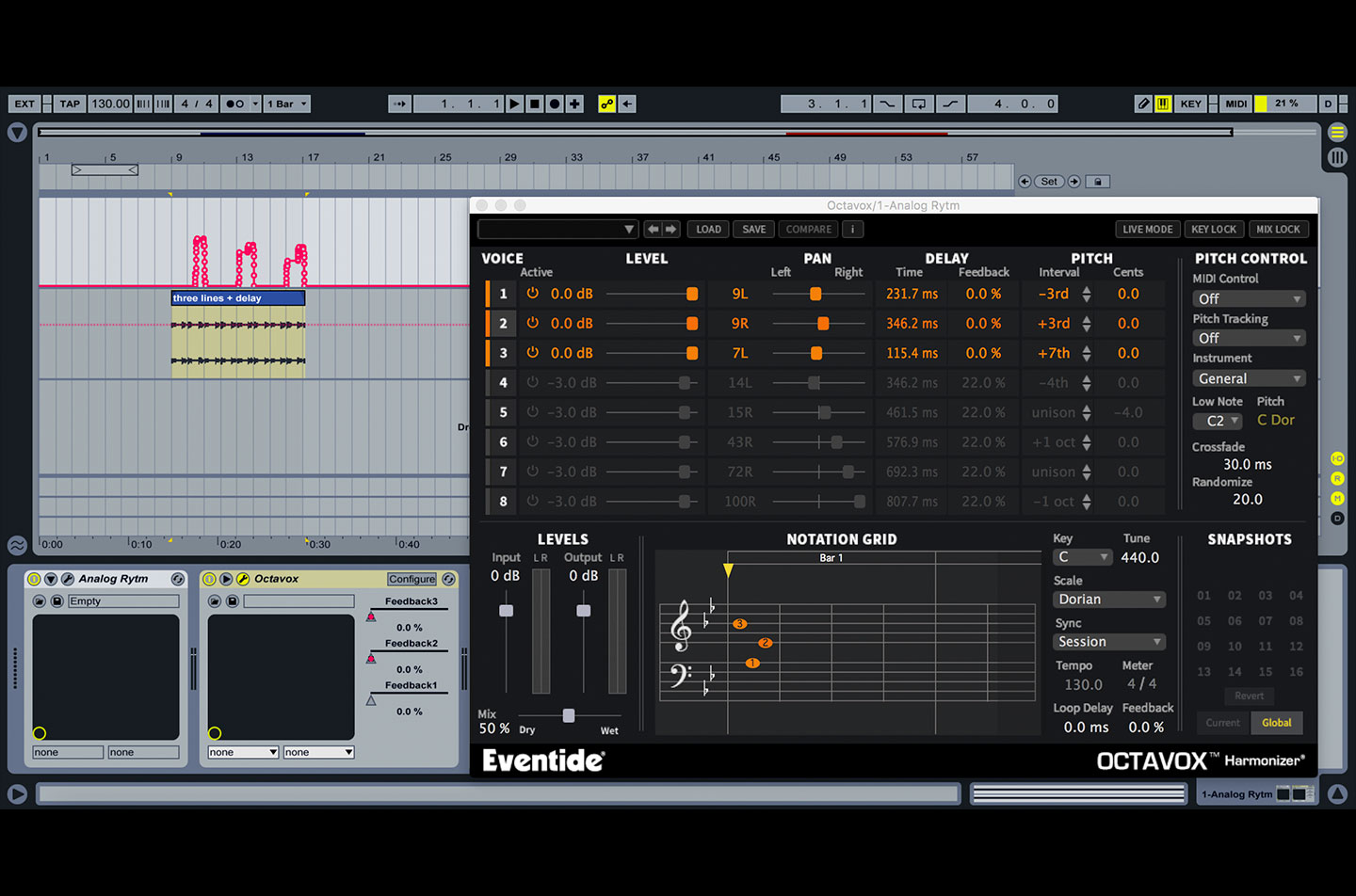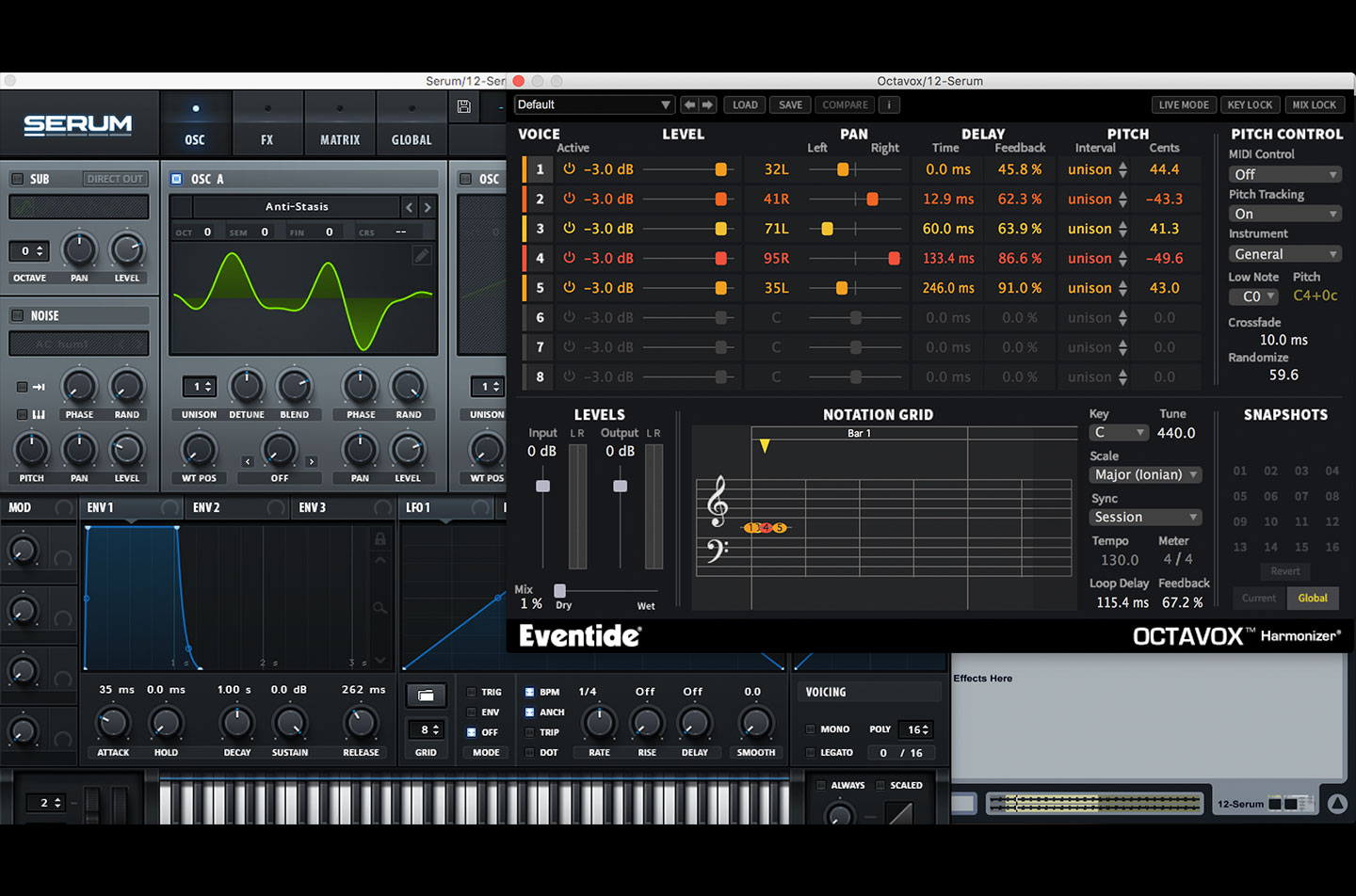- Eventide's Octavox has been around for a while as part of the Anthology X bundle, but it only got a standalone release earlier in 2016. It's a diatonic pitch shifter and delay with eight voices. Each voice has a bypass switch and controls for level, pan, delay time, feedback and pitch, which can be set by interval or cents. The inclusion of a notation grid and the ability to automatically sync pitches to a preselected scale indicate that the plug-in seems oriented to the Western songwriting world: think of turning a palm-muted, crotchet guitar figure into an Edge-esque sparkle of rolling arpeggios, or layering parallel harmonies onto a backing vocal track. Most of Eventide's own demos reflect this sort of mindset, which means its appeal to electronic dance music producers isn't necessarily obvious at first glance. Using a popular drum machine and soft synth—namely, an Elektron Analog RYTM and the XferRecords Serum—we'll show some basic examples (untreated with EQ, compression or the like) of how you might use the Octavox in your own productions.
One of the plug-in's key strengths is its ability to make relatively underwhelming source material into something interesting. Generally, it's best to keep the audio you're feeding into Octavox sparse, as it has a habit of filling up the gaps with rhythmic, pitched delays. In this case, we're starting with a simple FM bass sound from the Analog RYTM.
Now we switch on the Octavox and add three delay lines set to different pitches and slightly spread in the stereo field, as you can see in the screen grab above. Automating the feedback settings for each delay line is an easy way to add rhythmic accents and vitality, which in this case adds sixteenth-note accents to certain notes.
Again, it's important not to get too busy with the rhythms you're sending to the Octavox. It's tempting to switch on a bunch of voices and tinker away, but I had much better luck using sparsely placed bits of audio and relying on the plug-in to create interest, rather than the source itself. For instance, I placed randomly pitched FM snares on the second crotchet of every bar, instead of every two and four, in order to not overload the Octavox. In this case, adding three widely spread delay lines creates ghost notes whose pitches seem to wander about on their own accord.
For the hats, we've entered four delay lines that are all down-pitched and occur at longer delay times than the other two percussion parts. Slight parameter changes to the decay of the hat interact with the long delay times, allowing us to create a cascading effect. Add in a simple kick and clap pattern and we have ourselves a serviceable electro beat whose interest is largely the product of the Octavox injecting rhythmic and harmonic details to a stale pattern. In that sense, there's something to be said for writing beats for the Octavox, rather than using it to spice up a beat you've already written.
The Octavox can also be used in a more traditional dub fashion via an effects send. In this case, busier settings can create interesting textural effects thanks to a combination of phasing pitches and multiple delay patterns. We'll show this through a formulaic breakdown. The drums are now grouped and being sent to a high-passed send containing an Octavox set to the "Alien Message" preset, which creates a sound that wouldn't be out of place on a Dopplereffekt record. We'll simply take out the kick, send the audio to the Octavox bus, increase the feedback and bring back the kick drum.
Combing pitch and delay effects is a no-brainer for breakdowns like this, and the Octavox proves handy in this sense: both tools are in a single plug-in, with every voice individually controllable with modulation. But the Octavox is also handy for turning humble waveforms into more arresting, complex sounds. It especially excels at creating disquieting, textured drones that work great in a techno context. The temptation with the Octavox is to always pursue rhythmic, pitched delays, but it can be used in a manner more like a chorus effect.
In this example, five delay lines have been activated and spread around the stereo field. The delay times have been set at rough intervals between 12 and 246 milliseconds and re-pitched slightly using the Cents control on each voice, which you can see in the following screen grab. The feedback has also been jacked up on each voice and on the Notation Grid, where we've also set a short loop delay of a bit over 100 milliseconds. Finally, some randomisation has been added in the pitch control section. All of this combines into a wide, ominous, microtonal drone. The change is obvious when introducing the effect to the Serum's waveform. For more flavour, users of Max For Live can attach randomised LFOs to the pitches and feedback amounts of the delay lines.
Since this detuned pad indicates something of a techno tip, we'll take a kick drum that lands on the one and three of each bar and turn it into a rolling techno loop with the Octavox. Raising the pitch up to a seventh on the quaver proceeding the down beat helps push momentum into each bar, while a bass tone on the Serum is spread out and pitched to create a minor ninth chord.
One of Octavox's strengths is creating evolving melodic sequences. It's relatively simple to make loops that sound polyrhythmic and dynamic, especially with extra modulation to pitch and feedback parameters. To demonstrate, we'll take a basic tom pattern from the Analog RYTM and activate, one by one, four delay lines set to pitches that complement the source.
You can do this largely by ear—just experiment with choosing different scale types and introduce a single voice at a time, finding a complementary pitch before moving on to the next voice. In this audio example, we'll add each voice incrementally. A surprising degree of complexity emerges over time as we've got a few more Max For Live LFO's modulating the feedback times.
Then all that's left to do is add it to our preexisting loop.
Despite the way it's marketed, the Octavox is certainly something worth considering if you're making electronic dance music. In practice, I found that I got the most out of the plug-in when allowing it to do the bulk of the work—often, inputting simpler material ended up with better results. It's a strong compositional tool, in that it can easily turn source audio into something with a different function, whether it's rhythmic, harmonic or spatial. It's also a cinch to use. Though it's not an essential tool, those who spend time with it and get past its more obvious applications will find a plug-in that can change the way you work and offer a different angle through which to approach your productions.
Ratings:
Cost: 3.3
Versatility: 3.6
Sound: 4.6
Ease of use: 4.7
 Since this detuned pad indicates something of a techno tip, we'll take a kick drum that lands on the one and three of each bar and turn it into a rolling techno loop with the Octavox. Raising the pitch up to a seventh on the quaver proceeding the down beat helps push momentum into each bar, while a bass tone on the Serum is spread out and pitched to create a minor ninth chord. One of Octavox's strengths is creating evolving melodic sequences. It's relatively simple to make loops that sound polyrhythmic and dynamic, especially with extra modulation to pitch and feedback parameters. To demonstrate, we'll take a basic tom pattern from the Analog RYTM and activate, one by one, four delay lines set to pitches that complement the source.
Since this detuned pad indicates something of a techno tip, we'll take a kick drum that lands on the one and three of each bar and turn it into a rolling techno loop with the Octavox. Raising the pitch up to a seventh on the quaver proceeding the down beat helps push momentum into each bar, while a bass tone on the Serum is spread out and pitched to create a minor ninth chord. One of Octavox's strengths is creating evolving melodic sequences. It's relatively simple to make loops that sound polyrhythmic and dynamic, especially with extra modulation to pitch and feedback parameters. To demonstrate, we'll take a basic tom pattern from the Analog RYTM and activate, one by one, four delay lines set to pitches that complement the source. You can do this largely by ear—just experiment with choosing different scale types and introduce a single voice at a time, finding a complementary pitch before moving on to the next voice. In this audio example, we'll add each voice incrementally. A surprising degree of complexity emerges over time as we've got a few more Max For Live LFO's modulating the feedback times. Then all that's left to do is add it to our preexisting loop. Despite the way it's marketed, the Octavox is certainly something worth considering if you're making electronic dance music. In practice, I found that I got the most out of the plug-in when allowing it to do the bulk of the work—often, inputting simpler material ended up with better results. It's a strong compositional tool, in that it can easily turn source audio into something with a different function, whether it's rhythmic, harmonic or spatial. It's also a cinch to use. Though it's not an essential tool, those who spend time with it and get past its more obvious applications will find a plug-in that can change the way you work and offer a different angle through which to approach your productions. Ratings: Cost: 3.3 Versatility: 3.6 Sound: 4.6 Ease of use: 4.7
You can do this largely by ear—just experiment with choosing different scale types and introduce a single voice at a time, finding a complementary pitch before moving on to the next voice. In this audio example, we'll add each voice incrementally. A surprising degree of complexity emerges over time as we've got a few more Max For Live LFO's modulating the feedback times. Then all that's left to do is add it to our preexisting loop. Despite the way it's marketed, the Octavox is certainly something worth considering if you're making electronic dance music. In practice, I found that I got the most out of the plug-in when allowing it to do the bulk of the work—often, inputting simpler material ended up with better results. It's a strong compositional tool, in that it can easily turn source audio into something with a different function, whether it's rhythmic, harmonic or spatial. It's also a cinch to use. Though it's not an essential tool, those who spend time with it and get past its more obvious applications will find a plug-in that can change the way you work and offer a different angle through which to approach your productions. Ratings: Cost: 3.3 Versatility: 3.6 Sound: 4.6 Ease of use: 4.7